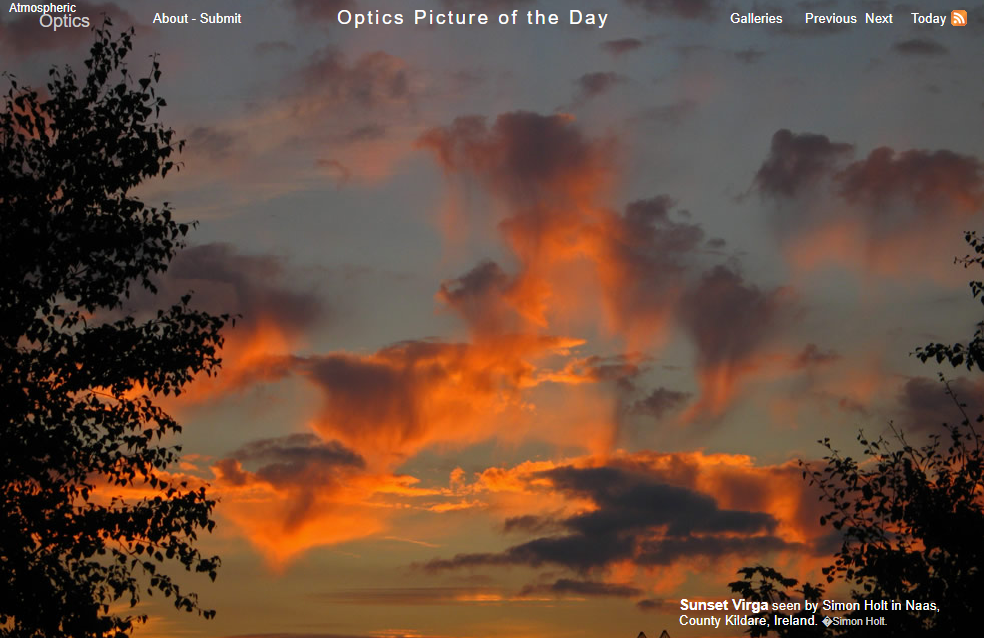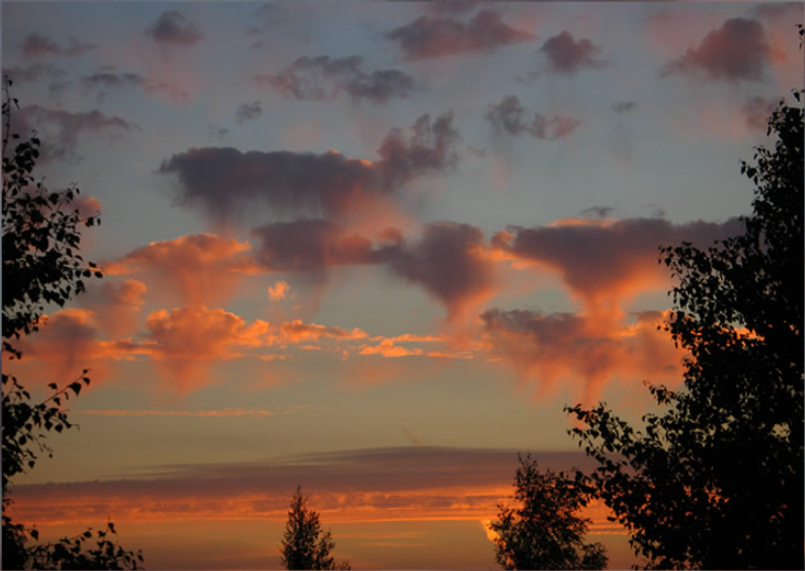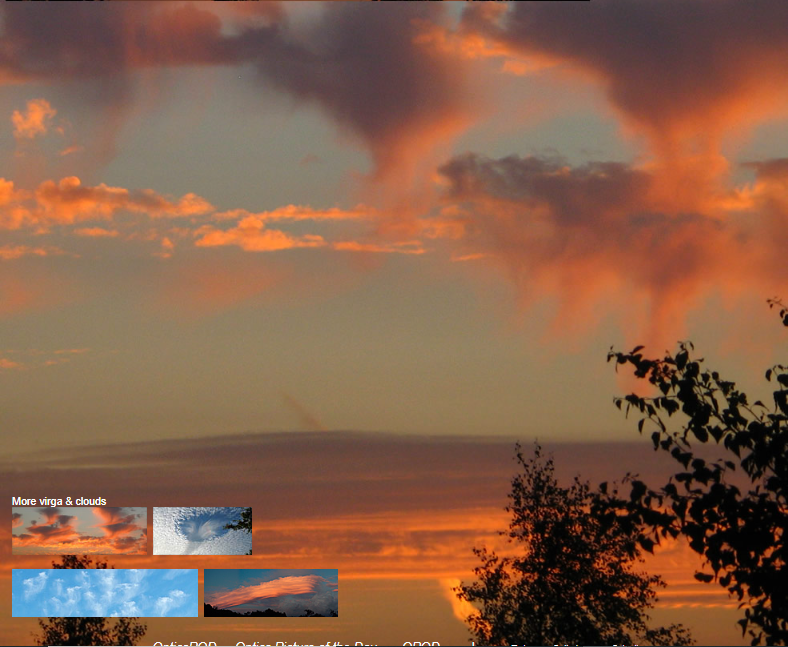Virga
Virga: The Spectacular Phenomenon of Falling Raindrops and Ice Crystals
Have you ever looked up at the sky and noticed curved tendrils hanging downwards from the clouds? These mesmerizing formations are known as virga or fallstreaks. They create a breathtaking spectacle, especially when illuminated by the rays of a setting sun. But what exactly are virga, and how do they form?
Virga refers to streams of raindrops, snowflakes, or even halo-forming ice crystals that fall from the clouds but evaporate before reaching the ground. This intriguing atmospheric phenomenon can be observed from various levels of cloud cover, but it is most commonly seen in medium-level altocumulus, altostratus, and higher cirrus clouds.
One of the distinctive features of fallstreaks is their hook-shaped appearance. This shape is often caused by differences in wind speed at different heights, known as wind shear. Wind shear can create the conditions necessary for the formation of these captivating cloud formations.
Another contributing factor to the formation of virga is the evaporation and shrinking of water droplets or ice crystals as they descend from the clouds. As these particles gradually evaporate and decrease in size, their descent slows down, eventually leading them to drift horizontally with the prevailing wind.
Virga is a fascinating phenomenon that has captivated sky gazers for centuries. Its unique characteristics and ethereal beauty make it a subject of interest for meteorologists and cloud enthusiasts alike. Here are some key points to help you better understand and appreciate this natural wonder:
-
Types of Virga: Virga can manifest in different forms, including rain virga, snow virga, and ice crystal virga. Each type is characterized by the specific particles involved in the formation process.
-
Rain Virga: Rain virga occurs when raindrops fall from the clouds but evaporate before reaching the surface. This phenomenon is commonly observed in arid or desert regions, where the lower atmospheric humidity facilitates rapid evaporation.
-
Snow Virga: Snow virga refers to the process in which snowflakes fall from the clouds but sublimate (transition directly from solid to gas) before reaching the ground. This occurrence is more prevalent in colder regions where the temperature near the surface is below freezing.
-
Ice Crystal Virga: Ice crystal virga involves the descent of ice crystals from the clouds, which subsequently evaporate before reaching the surface. These ice crystals can contribute to the formation of various optical phenomena, such as halos and sun dogs.
-
Cloud Levels: While virga can be observed from different cloud levels, they are most commonly seen in medium-level altocumulus and altostratus clouds, as well as higher cirrus clouds. These cloud types provide the ideal conditions for the formation and visibility of fallstreaks.
-
Wind Shear: Wind shear plays a crucial role in shaping the distinctive hook-like appearance of fallstreaks. Differences in wind speed and direction at different altitudes create an environment conducive to the formation of these intriguing cloud formations.
-
Evaporation and Drifting: As water droplets or ice crystals descend from the clouds, they undergo a process of evaporation and shrinking. This causes their descent to slow down, eventually leading them to drift horizontally with the prevailing wind. This drifting motion adds to the mesmerizing visual display of virga.
-
Photographic Opportunities: The unique beauty of virga, especially when illuminated by the warm hues of a setting sun, presents excellent photographic opportunities. Capturing these ethereal formations against a backdrop of vibrant colors can result in stunning and captivating images.
-
Meteorological Significance: Studying virga can provide valuable insights into atmospheric conditions and processes. Observing the presence and behavior of fallstreaks can aid meteorologists in understanding the moisture content and dynamics of the atmosphere at different altitudes.
-
Appreciating Nature's Wonders: Virga serves as a reminder of the vast and awe-inspiring phenomena occurring in our atmosphere. Taking the time to observe and appreciate these natural wonders can deepen our connection with the world around us and inspire a sense of wonder and curiosity.
In conclusion, virga is a captivating atmospheric phenomenon that showcases the intricate interplay between clouds, precipitation, and evaporation. Its unique characteristics and visual appeal make it a subject of fascination for sky gazers and scientists alike. By understanding the formation processes and appreciating the beauty of virga, we can gain a deeper appreciation for the wonders of our natural world. So, next time you find yourself gazing up at the sky, keep an eye out for these mesmerizing fallstreaks and let yourself be captivated by their fleeting beauty.

Sunset Virga seen by Simon Holt in Naas, County Kildare, Ireland. �Simon Holt.

Curved tendrils hang downwards from the clouds. They are virga or fallstreaks. As here, they they are at their most spectacular when lit by the rays of a setting sun.
Virga are streams of raindrops, snowflakes or even halo forming ice crystals. They fall from the clouds but evaporate before reaching the ground.
Virga can be seen from all levels of cloud but more usually from medium level altocumulus, altostratus and from higher cirrus.
Fallstreaks are characteristically hook shaped. Differences in wind speed with height (wind shear) can be responsible.
Another factor is that as the water droplets or ice crystals evaporate and shrink they fall ever more slowly and finally drift horizontally with the wind.

Note: this article has been automatically converted from the old site and may not appear as intended. You can find the original article here.
Reference Atmospheric Optics
If you use any of the definitions, information, or data presented on Atmospheric Optics, please copy the link or reference below to properly credit us as the reference source. Thank you!
-
<a href="https://atoptics.co.uk/blog/virga/">Virga</a>
-
"Virga". Atmospheric Optics. Accessed on November 26, 2024. https://atoptics.co.uk/blog/virga/.
-
"Virga". Atmospheric Optics, https://atoptics.co.uk/blog/virga/. Accessed 26 November, 2024
-
Virga. Atmospheric Optics. Retrieved from https://atoptics.co.uk/blog/virga/.